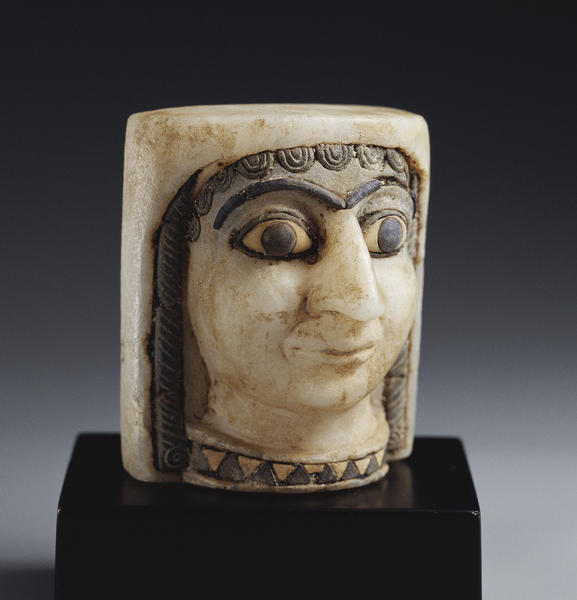女性頭部
- メソポタミア 初期王朝第三期
- 前2500年頃
- 雪花石膏、ラピスラズリ
- H-7.4 W-6.7
この作品は立体的で、雪化石膏を使いほぼ丸彫りで女性の顔面を表している。そして被り物の下から見せる同心の半円を垂らして並べる前髪と両脇に下がる髪の房、ラピスラズリの象嵌で表された眉が眉間でつながり、鼻を高く表している。この表現は、ベルリン近東博物館所蔵のシュメール初期王朝時代の石製容器断片に表された女神の姿と大変近い特徴を持っており、この作品の髪の房末端がカールしている表現もこの女神と共通する点である。この石製容器の女神の姿は穀物神ニサバと考えられているが、これら三例とも豊穣の女神らしい優しいほほえみをたたえている。古代メソポタミアの神殿に奉納されたのは彫像だけではなく、様々な場面を表した壁の装飾板や容器もあった。時にそのような場面には神々の姿とともに奉納者である礼拝者の姿も表現された。この作品もそのような奉納物の一部であったのかもしれない。
Catalogue Entry
This image depicts a female face rendered in relief on a lapis lazuli panel. Her forelocks, showing under the band around the bottom of her crown, are represented as a series of concentric semicircles and ovals, and at the left and right edges of the panel is relief work depicting further locks of hair hanging down both sides of her face. Her eyebrows join in the middle of her forehead and the bridge of her nose is prominent. Comparing this female head with the one at cat. no. 004, we see that the latter is made mainly of alabaster and is more three-dimensional?almost sculpture in the round?but nonetheless it has a lot in common with the former, including a line of concentric semicircles to indicate strands of hair peeking out from under the headwear, longer locks of hair hanging to both sides of the face, inlaid eyebrows of lapis lazuli that meet between the eyes, and a prominent nose. These facial features are very close in form to that of a goddess image sculpted on a Sumerian Early Dynastic-period stone vessel fragment in the collection of the Vorderasiatisches Museum (Museum of the Ancient Near East; part of the Pergamon Museum) in Berlin, as is the rendering of the curling tips of the longer locks of hair in cat. no. 004. The goddess depicted on the stone vessel fragment is thought to be Nisaba, goddess of grain, and all three examples depict female faces with gentle smiles befitting such a goddess of fertility and abundance. The people of ancient Mesopotamia dedicated to their temples not only sculptures but also such items as vessels and decorative wall panels bearing depictions of various scenes. In some such scenes the worshipper who dedicated the item is depicted along with images of divine beings, and cat. nos. 004 and 005 may have been part of temple-dedicated works of that kind.
